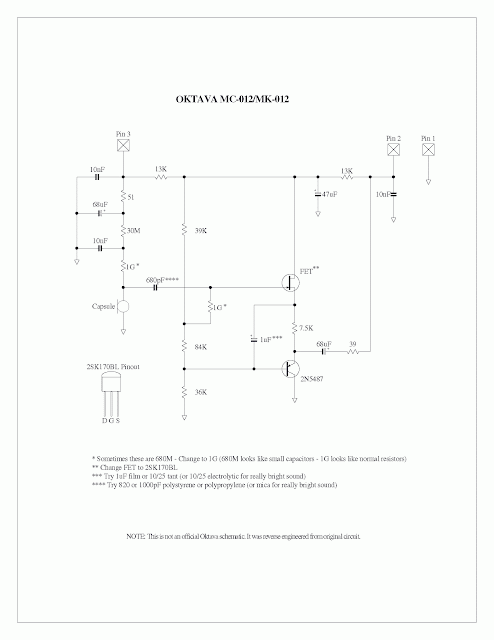Hello to the community!
I have the idea to build some preamplifiers for the Oktava 012 capsule. My first idea was to buy the stock microphones and mod them, but after a few inquiries I decided to build them (they will cost much less).
I'm following the article by Lucas Adamson ( http://oktavamk012rebuild.blogspot.it/2012/01/introducing-oktava-mk-012-mc-012-ok-so.html ) and the Scott Dorsey mod ( http://www.recordingmag.com/resources/resourceDetail/315.html ).
My question is about what components should I use: is it relevant to say that some of the components suggested by Scott Dorsey are chosen for its dimensions (other won't fit in a original oktava tube) but I'm planning to build a completely new preamplifer, so no space problems here.
I have a friend which has the possibility to rewrite the PCB and make it printed from a online service.
schematics:

Capacitors:
C1: Dorsey specifies a "Panasonic COG ceramic types, usually an 820 pF value" while Lucas uses a "820pF Silver mica input DC blocking cap". Which would be the best? I read that the silver mica could be brighter on the final sound.
C2: I found the Vishay 1uF 160v MKP. Would be ok?
C3,C4 (and C5): Dorsey specifies Vishay BCC electrolytic capacitors ( http://www.digikey.it/product-detail/it/MAL202138689E3/4073PHCT-ND/263276 ) while Lucas uses Panasonic FC capacitors, which are bigger ( http://www.digikey.it/product-detail/it/EEU-FC1J680/P10341-ND/266350 ).
C6,C7,C8: 10nF are specified on the schematics, while Lucas uses 47nF 63v Wima Polyester MKS02. Are them ok?
Transistors: the Q2 is ok (Toshiba A1015Y) ?
This is my actual list, the same of Lucas Adamson's blog, with reference (Q1...ecc) and prices from the sellers in Euro:
Transistors:
1x Toshiba 2SK170 BL Q1 6pc 10.62 Ebay
1x Toshiba A1015 Y Q2 10pc 5.08 Ebay
Capacitors:
1x 820pF Silver mica C1 5pc 13.79 RS
1x Vishay 1uF 160v MKP C2 5pc 7.87 Ebay
2x 68uF 63v Panasonic FC C3,C4 10pc 3.90 DigiKey
1x 47uF 63v Panasonic FC C5 5pc 2.00 Digikey
3x 47nF 63v Wima Polyester MKS02 C6,C7,C8 15pc 8.19 Farnell
Resistors:
4x 1GOhm MOX200001007JE R1,R2 20pc 59.40 Digikey
1x 39R0 1% 0.6W Vishay R3 50pc 2.95 RS
1x 7K5 Welwyn RC55Y R4 5pc 7.15 Farnell
2x 13K0 Welwyn RC55Y R5,R6 10pc 12.90 Farnell
1x 39K2 Welwyn RC55Y R7 5pc 6.50 Farnell
1x 84K5 Welwyn RC55Y R8 5pc 1.38 RS
1x 36K0 Welwyn RC55Y R9 5pc 0.60 Digikey
1x 51R1 Welwyn RC55Y R10 5pc 3.42 Farnell
1x 33M0 Vishay 0.5W R11 10pc 1.88 Farnell
---------------------------------------------
About the preamplifier, I found 20mm Aluminium pipes from a local store, which should match exactly the silver Oktava capsule set.
I will use Neutrik connectors (NC MX, silver ones).
My mainly problem is how to fix the capsule on the head of the aluminium pipe.
I attached a scratch, which is similar to the original Oktava microphone.
Thanks you!
mark
I have the idea to build some preamplifiers for the Oktava 012 capsule. My first idea was to buy the stock microphones and mod them, but after a few inquiries I decided to build them (they will cost much less).
I'm following the article by Lucas Adamson ( http://oktavamk012rebuild.blogspot.it/2012/01/introducing-oktava-mk-012-mc-012-ok-so.html ) and the Scott Dorsey mod ( http://www.recordingmag.com/resources/resourceDetail/315.html ).
My question is about what components should I use: is it relevant to say that some of the components suggested by Scott Dorsey are chosen for its dimensions (other won't fit in a original oktava tube) but I'm planning to build a completely new preamplifer, so no space problems here.
I have a friend which has the possibility to rewrite the PCB and make it printed from a online service.
schematics:

Capacitors:
C1: Dorsey specifies a "Panasonic COG ceramic types, usually an 820 pF value" while Lucas uses a "820pF Silver mica input DC blocking cap". Which would be the best? I read that the silver mica could be brighter on the final sound.
C2: I found the Vishay 1uF 160v MKP. Would be ok?
C3,C4 (and C5): Dorsey specifies Vishay BCC electrolytic capacitors ( http://www.digikey.it/product-detail/it/MAL202138689E3/4073PHCT-ND/263276 ) while Lucas uses Panasonic FC capacitors, which are bigger ( http://www.digikey.it/product-detail/it/EEU-FC1J680/P10341-ND/266350 ).
C6,C7,C8: 10nF are specified on the schematics, while Lucas uses 47nF 63v Wima Polyester MKS02. Are them ok?
Transistors: the Q2 is ok (Toshiba A1015Y) ?
This is my actual list, the same of Lucas Adamson's blog, with reference (Q1...ecc) and prices from the sellers in Euro:
Transistors:
1x Toshiba 2SK170 BL Q1 6pc 10.62 Ebay
1x Toshiba A1015 Y Q2 10pc 5.08 Ebay
Capacitors:
1x 820pF Silver mica C1 5pc 13.79 RS
1x Vishay 1uF 160v MKP C2 5pc 7.87 Ebay
2x 68uF 63v Panasonic FC C3,C4 10pc 3.90 DigiKey
1x 47uF 63v Panasonic FC C5 5pc 2.00 Digikey
3x 47nF 63v Wima Polyester MKS02 C6,C7,C8 15pc 8.19 Farnell
Resistors:
4x 1GOhm MOX200001007JE R1,R2 20pc 59.40 Digikey
1x 39R0 1% 0.6W Vishay R3 50pc 2.95 RS
1x 7K5 Welwyn RC55Y R4 5pc 7.15 Farnell
2x 13K0 Welwyn RC55Y R5,R6 10pc 12.90 Farnell
1x 39K2 Welwyn RC55Y R7 5pc 6.50 Farnell
1x 84K5 Welwyn RC55Y R8 5pc 1.38 RS
1x 36K0 Welwyn RC55Y R9 5pc 0.60 Digikey
1x 51R1 Welwyn RC55Y R10 5pc 3.42 Farnell
1x 33M0 Vishay 0.5W R11 10pc 1.88 Farnell
---------------------------------------------
About the preamplifier, I found 20mm Aluminium pipes from a local store, which should match exactly the silver Oktava capsule set.
I will use Neutrik connectors (NC MX, silver ones).
My mainly problem is how to fix the capsule on the head of the aluminium pipe.
I attached a scratch, which is similar to the original Oktava microphone.
Thanks you!
mark





